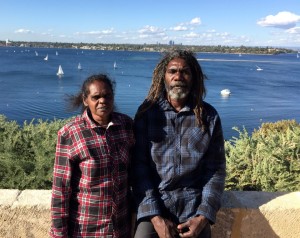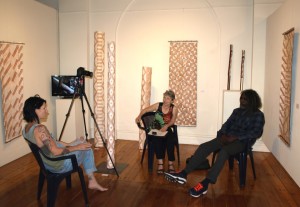Film Sparks Youth Interest In Art From Hamish Garrgarrku
April 2, 2015 by David Wroth
 Film maker Natalie Carey is making a documentary about Hamish Garrgarrku (formerly Karrkarrhba) and his work. We were delighted to have Natalie with us for the launch of Hamish's first solo exhibition here at Japingka Gallery. In this interview Natalie chats with us about this video and how it has engaged the younger members of the community to learn more about Hamish and his painting.
Film maker Natalie Carey is making a documentary about Hamish Garrgarrku (formerly Karrkarrhba) and his work. We were delighted to have Natalie with us for the launch of Hamish's first solo exhibition here at Japingka Gallery. In this interview Natalie chats with us about this video and how it has engaged the younger members of the community to learn more about Hamish and his painting.
Q. When did you first have the idea to make this video?
Natalie: It first came up last year around the time Japingka starting talking about Hamish coming down for the exhibition. I’d started running the Music and Media Centre in Maningrida. We were working very closely in collaboration with the Maningrida Arts and Culture Centre. It’s a Wiwa Project and it’s basically about recording the language and culture through arts mediums with artists and also dancers and doing things out in country and with ceremony. So it seems like a very natural partnership for us to do a story about Hamish from the beginning. We've covered right from when the seed was planted about the exhibition. We've been able to follow this artist on the whole journey all the way through from collecting the materials, to the creation of the works and then to come to the city for the first time and attend the opening of the exhibition. So it was early last year that Lucy approached me and said I think this would be a really cool thing for us to do.
Q. Have you enjoyed it Hamish?
Hamish:Yes, yes. (Laughs)
Natalie: Hamish is affiliated with the Wiwa Project and some of Hamish’s young family are part of the Wiwa crew. So its been beautiful because their training has actually taken place while they’re getting to document their family, their father, their uncle, their brother. They have different kinship relationships to Hamish but same country, same clan group, the Namundja mob. So it’s his own family who have done a lot of the filming and recording up country.
Q. Have you learnt a lot from this process?
Natalie: Yes. I’ve learnt an incredible amount. I've gained a lot of new insight into the art and Hamish’s particular country. I’ve worked with Jennifer (Hamish's wife) at the Women’s Centre for a while. I’m good friends with her and her sisters, Debra and Susan. So I’ve heard stories from the women’s point of view and spent a lot of time with them. Working with Hamish is the juxtaposition again. So its the same stories but a different approach.
Q. What insights have you learnt about the art side of things?
 Natalie: There’s been some amazing insights out bush. It’s one of those things that you can really only come to it you’re spending a lot of time. We’re taking a lot of time. There’s no rush. We’ll spend a whole day out bush. We’ll go on to country and do lots of talking. We do a lot of talking in Hamish’s own language. I’ve really said to Hamish I’m happy for you to speak in Kunijku because speaking in his own language there’s just so much more information. There’s just so much more ability to articulate the depth of stories.
Natalie: There’s been some amazing insights out bush. It’s one of those things that you can really only come to it you’re spending a lot of time. We’re taking a lot of time. There’s no rush. We’ll spend a whole day out bush. We’ll go on to country and do lots of talking. We do a lot of talking in Hamish’s own language. I’ve really said to Hamish I’m happy for you to speak in Kunijku because speaking in his own language there’s just so much more information. There’s just so much more ability to articulate the depth of stories.
We come back and do the translation with the boys in the media room. The Kunijku stuff really has a wow factor. It has all of this rich depth of information about particular areas and the nature in those places. For example, the translation tells what it means to approach a tree and see a painting on it before you’ve even touched it. You know this gives insight into the connection that this Bininj mob have to their country. It’s unbelievable how spiritual their relationship with the land actually is. There’s not one aspect of what these people do on country that isn’t a deeply spiritual or deeply connected act. There’s a co-existence with the country and with the land. The language Kunijku represents the secrets, the fabric of that area.
Q. Do you feel that you are at the end of film making process?
Natalie: The final version is still quite a long way off. I’m really trying to keep my hands off it as much as possible. I’d like the young guys to do most of the filming and most of the editing. It’s about empowering the community to have the ability to create their own history and content for future generations. It means that they’re not having to rely on the outsiders to come in to facilitate that. It takes a long time but it’s definitely worth it. It’s been good for us to all work together on this. It’s really engaged the younger people.
They’ve been engaged because it’s their language and their people. They really want to know what’s going on. They have a lot invested and they really want to be part of the process. Through this video the younger boys have got to learn all about Hamish’s work.
Hamish: This is a story for them. This is a story for them to remember. As for the paintings, there are many more of those to come.
Read more:
